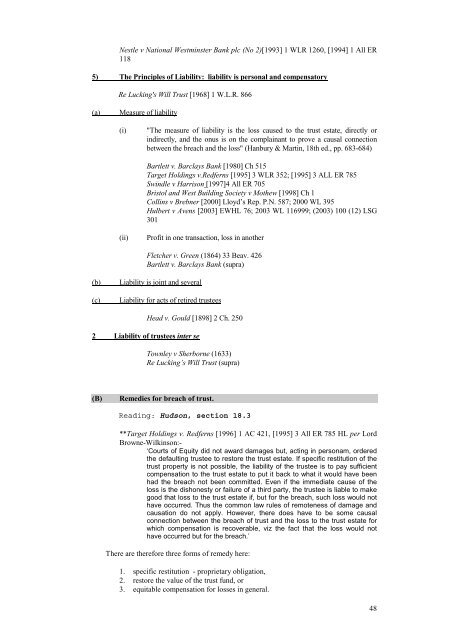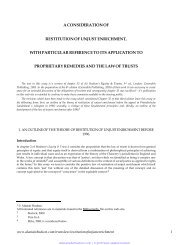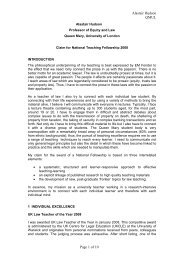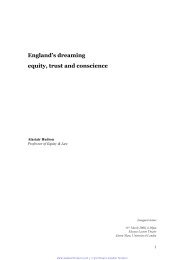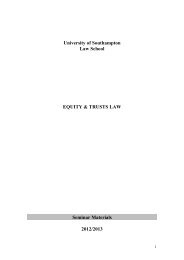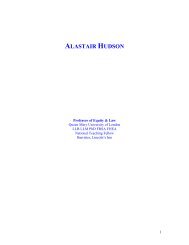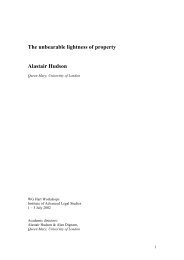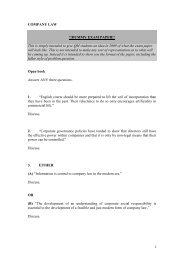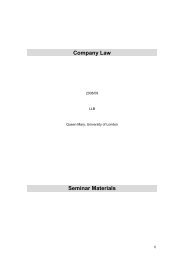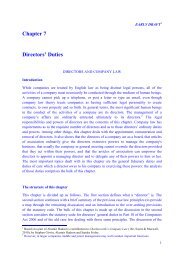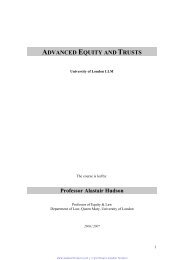Soton Equity and Trusts - alastairhudson.com
Soton Equity and Trusts - alastairhudson.com
Soton Equity and Trusts - alastairhudson.com
Create successful ePaper yourself
Turn your PDF publications into a flip-book with our unique Google optimized e-Paper software.
Nestle v National Westminster Bank plc (No 2)[1993] 1 WLR 1260, [1994] 1 All ER<br />
118<br />
5) The Principles of Liability: liability is personal <strong>and</strong> <strong>com</strong>pensatory<br />
Re Lucking's Will Trust [1968] 1 W.L.R. 866<br />
(a)<br />
Measure of liability<br />
(i)<br />
"The measure of liability is the loss caused to the trust estate, directly or<br />
indirectly, <strong>and</strong> the onus is on the <strong>com</strong>plainant to prove a causal connection<br />
between the breach <strong>and</strong> the loss" (Hanbury & Martin, 18th ed., pp. 683-684)<br />
Bartlett v. Barclays Bank [1980] Ch 515<br />
Target Holdings v.Redferns [1995] 3 WLR 352; [1995] 3 ALL ER 785<br />
Swindle v Harrison [1997]4 All ER 705<br />
Bristol <strong>and</strong> West Building Society v Mothew [1998] Ch 1<br />
Collins v Brebner [2000] Lloyd’s Rep. P.N. 587; 2000 WL 395<br />
Hulbert v Avens [2003] EWHL 76; 2003 WL 116999; (2003) 100 (12) LSG<br />
301<br />
(ii)<br />
Profit in one transaction, loss in another<br />
Fletcher v. Green (1864) 33 Beav. 426<br />
Bartlett v. Barclays Bank (supra)<br />
(b)<br />
(c)<br />
Liability is joint <strong>and</strong> several<br />
Liability for acts of retired trustees<br />
Head v. Gould [1898] 2 Ch. 250<br />
2 Liability of trustees inter se<br />
Townley v Sherborne (1633)<br />
Re Lucking’s Will Trust (supra)<br />
(B)<br />
Remedies for breach of trust.<br />
Reading: Hudson, section 18.3<br />
**Target Holdings v. Redferns [1996] 1 AC 421, [1995] 3 All ER 785 HL per Lord<br />
Browne-Wilkinson:-<br />
‘Courts of <strong>Equity</strong> did not award damages but, acting in personam, ordered<br />
the defaulting trustee to restore the trust estate. If specific restitution of the<br />
trust property is not possible, the liability of the trustee is to pay sufficient<br />
<strong>com</strong>pensation to the trust estate to put it back to what it would have been<br />
had the breach not been <strong>com</strong>mitted. Even if the immediate cause of the<br />
loss is the dishonesty or failure of a third party, the trustee is liable to make<br />
good that loss to the trust estate if, but for the breach, such loss would not<br />
have occurred. Thus the <strong>com</strong>mon law rules of remoteness of damage <strong>and</strong><br />
causation do not apply. However, there does have to be some causal<br />
connection between the breach of trust <strong>and</strong> the loss to the trust estate for<br />
which <strong>com</strong>pensation is recoverable, viz the fact that the loss would not<br />
have occurred but for the breach.’<br />
There are therefore three forms of remedy here:<br />
1. specific restitution - proprietary obligation,<br />
2. restore the value of the trust fund, or<br />
3. equitable <strong>com</strong>pensation for losses in general.<br />
48


